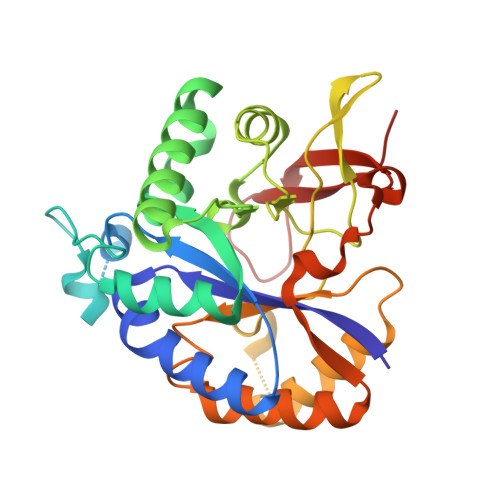Structure and Function of ArnD. A Deformylase Essential for Lipid A Modification with 4-Amino-4-deoxy-l-arabinose and Polymyxin Resistance.
Munoz-Escudero, D., Breazeale, S.D., Lee, M., Guan, Z., Raetz, C.R.H., Sousa, M.C.(2023) Biochemistry 62: 2970-2981
- PubMed: 37782650
- DOI: https://doi.org/10.1021/acs.biochem.3c00293
- Primary Citation of Related Structures:
8T0J - PubMed Abstract:
Covalent modification of lipid A with 4-deoxy-4-amino-l-arabinose (Ara4N) mediates resistance to cationic antimicrobial peptides and polymyxin antibiotics in Gram-negative bacteria. The proteins required for Ara4N biosynthesis are encoded in the pmrE and arnBCADTEF loci, with ArnT ultimately transferring the amino sugar from undecaprenyl-phospho-4-deoxy-4-amino-l-arabinose (C55P-Ara4N) to lipid A. However, Ara4N is N-formylated prior to its transfer to undecaprenyl-phosphate by ArnC, requiring a deformylase activity downstream in the pathway to generate the final C55P-Ara4N donor. Here, we show that deletion of the arnD gene in an Escherichia coli mutant that constitutively expresses the arnBCADTEF operon leads to accumulation of the formylated ArnC product undecaprenyl-phospho-4-deoxy-4-formamido-l-arabinose (C55P-Ara4FN), suggesting that ArnD is the downstream deformylase. Purification of Salmonella typhimurium ArnD (stArnD) shows that it is membrane-associated. We present the crystal structure of stArnD revealing a NodB homology domain structure characteristic of the metal-dependent carbohydrate esterase family 4 (CE4). However, ArnD displays several distinct features: a 44 amino acid insertion, a C-terminal extension in the NodB fold, and sequence divergence in the five motifs that define the CE4 family, suggesting that ArnD represents a new family of carbohydrate esterases. The insertion is responsible for membrane association as its deletion results in a soluble ArnD variant. The active site retains a metal coordination H-H-D triad, and in the presence of Co 2+ or Mn 2+ , purified stArnD efficiently deformylates C55P-Ara4FN confirming its role in Ara4N biosynthesis. Mutations D9N and H233Y completely inactivate stArnD implicating these two residues in a metal-assisted acid-base catalytic mechanism.
- Department of Molecular Cellular and Developmental Biology, University of Colorado Boulder, Boulder, Colorado 80309, United States.
Organizational Affiliation:
















